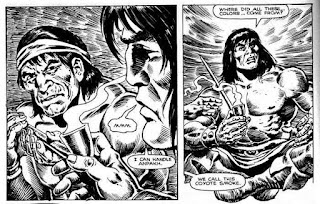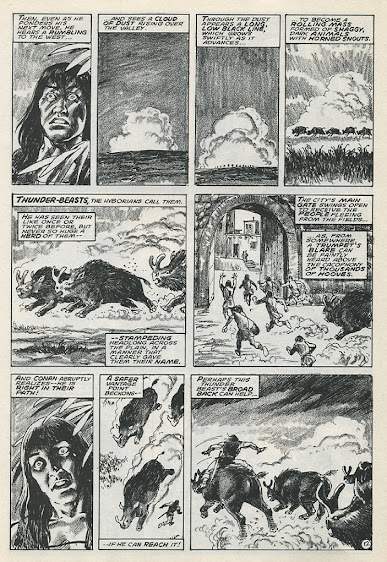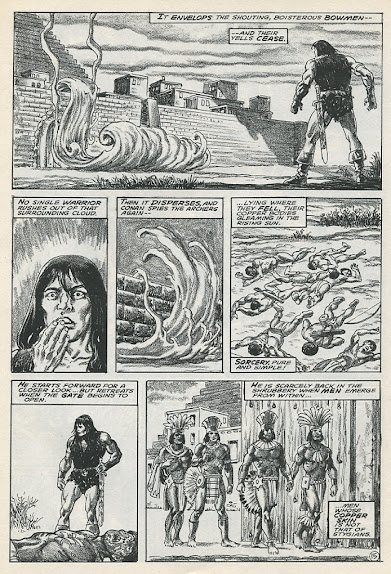In the last post, I explained how in the final current issue of Marvel's King Conan, Conan paddles off into the sunset, at last reaching the verdant coast of an unknown continent. This is either what is now called North or South America, or possibly an island off the coast.
Does this lead directly to L. Spraque L. DeCamp and Lin Carter's Conan of the Isles? Prince Conn is, and always has been a staple of Marvels chronicles of King Conan, is a Lin Carter creation (and has such has long been hated by Conan purists). De Camp intended his and Carter's A Probable Outline of Conan's career to be canonical. This was back during the barbarian boom of the sixties and seventies, Conan was going great guns at Marvel. The purist, with reason, vehemently disagreed, and now only the original Conan tales by Howard are considered canon, while the rest are basically pastiches. Therefor, all you can do is speculate.
Conan of the Isles has the sixty some year old monarch, bored of tedious court life, venturing across the Western Sea, to battle a conclave of wizard who survived the sinking of Atlantis. Most of the action takes place on Antilan islands off the coast of the Central American mainland, in the city of Patchuan ruled by the demon god Xotli. I remember from the book and comics adaptation the giant dragon-lizards in the pit beneath the city, that are dispose of the corpses of those sacrificed to the demon-god, and how Conan sets the dragons loose to terrorize the city. After defeating the priests and their evil god, Conan ventures further west, knowing there lies the even greater kingdom of Mayopan (undoubtedly proto-Mayans), "tiger-like cats" (jaguars), and another apparent demon god the Quetzalcoatyl (an Aztec deity; the Mayan name for essentially the same god is Kukulcan). It is easy to see the ancient meso-American culture in the place and character names, as well as a connection of Atlantis with those cultures.
None of this violates canon, as the tales of Conan as king by DeCamp and Carter, and the subsequent ones by Marvel, mostly by Roy Thomas, are based on a passage by Howard himself, that he journeyed to Khitai and other lands, including the two great continents across the Western ocean.
But's there's no mention of Patchuan or Xotli here. What the authors seem to have done is return to the source material, ignored the events of Conan of the Isles, and written their own version of what Conan might have encountered west of the Hyborian continent.
The fly in the ointment here is Prince Conn. As with Conan of the Isles, the prince assumes the throne after his father's abdication, but little else remains the same. Conn is already a part of Marvel's continuum, and was invented by DeCamp and Carter. Plus he's already a part of Marvel's expanded universe.
As is, of course. Conan of the Isles itself, which was adapted by Marvel in one issue of the annual "Red Shadows, Black Kraken", scrapped the next year in favor of a Jim Owsley story of two blonde twins with powers, one good the other evil, born during the era of King Kull--but that's another story. The entire adaptation of Carter's and DeCamp's pastiche was published in a graphic novel.
So what gives here?
Of course, Marvel hasn't always been consistent with it's use of Conan anyway. One thing I've always been confused by is whether of not the Marvel incorporated Howardian continuity into their own "universe." This was debated back and forth in the letters column back in the day. It seemed settle when one writer opined that Howard's Conan tales take place in a world that "will eventually become our world today, not the Marvel super heroes' world". The editors seemed to agree and that was that. Only there was a (very good) issue of What If, drawn by Ernie Chan that had Conan drawn into the modern world through the well of the sorcerer Shamash Shum Ukin, a villain from an early issue of Savage Sword. During his stay, there is a very brief cameo by Peter Parker and Mary Jane, proving that it's the Marvel super heroes' world after all! Another What If had Wolverine travel back to the Hyborian Age to team with Conan. There was at least one other What If that had Conan in the modern world, but I know next to nothing about it, other than it was still the same universe as Marvel. These instances were often dismissed for the fact that they were "what ifs" only, and never canonically occurred. But the Official Handbook of the Marvel Universe published around that time, made repeated references to the Hyborian Age, even including an entry on the Stygian god Set. The inclusion of Howard's hero in the now current Savage Avengers proves that Conan is, nowadays at least, a mainstay in the Marvel universe, as these stories are no "what ifs", but I have little idea of what goes on at Marvel these days. Only that having Conan adventure in modern Las Vegas (Zamora was the Hyborian Age's own "City of Sin"), is a far cry from the Howardian continuum, or even DeCamp's, Carter's, and Roy Thomas's subsequent embellishments.
But I've let myself get sidetracked again.
Conan of the Isles wasn't Conan's only venture to the Americas during Marvel's run, either. Sometime during the 90s Savage Sword run, Conan, while king of Aquilonia, traveled up the coast of South and North America, encountering a civilization that was either pro-Inca or Aztecs (probably Incan, as the name of capital Kuzco, suggests), the American Indians, and finally the Inuit where he slays a huge white whale feared by the natives as a god. On the page that featured a map of Western Hyborian age world-continent, they presented a map of the American continents as they existed during that time. As Africa and Eurasia were merged into one super landmass, so were the Americas, the Central American landmass being much wider and vaster.

The story above has Conan defeating an evil shaman, who is able to summon a monstrous bear spirit

Panel showing Conan smoking a native American peace pipe...

And communing with a coyote "Trickster" spirit

Prince Conn is merely a infant at this time, and his father has already had substantial adventures in the "New World" although he has reached here from the opposite direction than
Conan of the Isles, having sailed east from Khitai. So Conan's venture to these two lands is already established (at least within the Marvel universe) well before the DeCamp and Carter novel takes place.
There are two tales within the Howard canon that have a definite connection with the ancient Americas. One fits definitively with Conan's chronology, the other is, well, more controversial, being an original Howard tale, just not one about Conan. Until Roy Thomas converted into a Conan yarn for Marvel.
The first Howard story is "Red Nails" a Conan classic that has been adapted first by Roy Thomas and Barry Windsor-Smith back in Marvel Conan's early days, and then by another company in the 2000s for a three issue story arc in The Cimmerian. This series only adapts original Conan tales. "Red Nails" is one of Howard's originals that I wish would have been re-adapted by one of New Masters, preferably Tomas Giorello, one of the young artists who has assumed the throne of the Old Masters, but it has never happened.

The story had Conan and Valeria lost in the dense jungles of Darfar, when they have a run-in with a huge dragon, an apparent survival from prehistoric times. Conan slays the beast with a spear slimed with the juice of Derkata's Apples. Afterward, they come upon an abandoned city upon a flat plain. The city turns out to be a single vast palace with no open air streets or plazas, the walls, incredulously, of pure jade. This is not the first time Howard has Conan encounter a city like this. In Howard's "Xuthal of the Dusk," adapted by Roy Thomas as "The Slithering Shadow," Conan and the girl Natala discover a city of Xuthal in the desert that proves to be one vast pleasure palace, whose drugged inhabitants are the prey of a Lovecraftian entity called Thog.
Anyway, the city in "Red Nails" turns out to be not quite deserted after all. Conan saves a man from a seeming-supernatural entity, who takes them to a sealed-off sector of the palace-city It has become the feuding ground of two tribes of an unknown people who took refuge within its walls a century early. They are not city's original builders. Though once of a single tribe of refugees, a disagreement broke out among them and they split into two tribes when Techulli stole Xoctalanc's betrothed. They have been been slaughtering each other ever since, and vast network of darkened rooms between Techulti and Xochtalanc have become their battleground. The Techutli become the victors during Conan and Valeria's stay, and the Xoctalancas are wiped out; the victors bemoan the loss of a captive to flay alive. Their own dreams have been haunted ever since the feud's down of being captured and taken to Xoctalanc, the ultimate horror to meet the same grisly fate. For yes, whenever a warrior from the opposing tribe has been taken captive by the other, the poor devil is literally skinned, alive and screaming, for his captors' amusement.
It should be noted here that the ancient Aztecs worshipped a "flayed god" and often wore the skins of flayed sacrificial victims. Some North American Indian did flay captive enemies alive.
The name of the city is Xuchotl, not its original name, whose builders were presumably devoured by the stego-dragons (summoned by a wizard, out of some primordial age?) And the names of the inhabitants are meso-Amercian derivation as well. How then, did these American refugees end up in the heart of the main Hyborian world-continent? Howard does not tell us, and there has been speculative fiction on the part of other writers as to how they got there either.
What were they doing there?
There is one additional Conan tale of displaced Americans that might provide a connection, though not an answer. This is "Feeders from the Sky", aka "Nekht Semerkht" named for the title's villain and based on the original Howard tale of weird fiction set in America, Hyborianized by Roy Thomas. In it Conan encounters a strange city, this one of definite meso-american built with a central tiered temple. It is tended by slaves "whose copper-skins are not that of Stygians." Conan saves a girl, Princess Ixlaca, from an evil stygian sorcerer Nekht Semerkeht who tries to sacrifice insect -winged saurians, the feeders of the title. How again, did Ixlaca's people com to be in Stygia? And how did the come under the thrall of the wizard? Some like the author, whose detailed account the story can be found here:
https://classiccomics.org/thread/19/annotated-savage-sword-conan?page=95
are of the opinion that they might be of the same people as the inhabitants Xuchotl. As with "Red Nails" no explanation is provided by the author.
Brontotheriums of the Miocene, apparently one of few prehistoric creatures to have survived into the Hyborian age as rare animals. They are called "thunder-beasts" by the Hyborians, what their Latinate name really means, based in turn upon what the Native Americans called them. The Indians supposed the beasts crashed to earth during thunderstorms, and smashed themselves into the ground, where they found their bones!
Howard's original "Nekht Semerkeht" took place in North America, during Coronado's search for the legendary golden cities of Cibola (a false trail invented by the Indians to get rid of him). A lone Spaniard stumbles upon a strange city of Nekt Semerkeht, an ancient Egyptian sorcerer who, in Howard's version, is the one displaced. Once again, the hero must save a native princess from the winged monstrosities. But the conclusion was left unfinished by Howard, and science fiction author David Drake gave the story an ending that was not quite in keeping with Howardian heroism.
There is a passage from Howard's original, where the Spanish hero battles a native. Before the Indian is slain he sees in the gleaming armored Spaniard, "the doom of his entire race." Howard, a man of his times, wrote the story from the perspective of his protagonist, a white man; but that didn't mean he couldn't relate to the other man's perspective.
And what did Conan find out (perhaps the answer to the previous question?) once he rowed himself to the "New World," at the end of his long career in the known world of the Hyborian age. Neither Conan of the Isles, nor Marvels conclusion to Conan's tale provides. There has never been a tale of what Conan's true final adventures were--but someday, so long as Howard's hero stays the test of time, there may well be.


























Comments